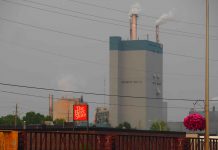 THUNDER BAY – Ontario communities Ignace, Schreiber and Hornepayne, along with Creighton in Saskatchewan, were assessed as having strong potential to meet site selection requirements and have been identified for further study as potential long-term storage sites for nuclear waste.
THUNDER BAY – Ontario communities Ignace, Schreiber and Hornepayne, along with Creighton in Saskatchewan, were assessed as having strong potential to meet site selection requirements and have been identified for further study as potential long-term storage sites for nuclear waste.
The Nuclear Waste Management Organization (NWMO) has completed the first phase of preliminary assessment in collaboration with eight of the 21 communities that expressed interest in learning about Canada’s plan for the safe, long-term management of used nuclear fuel.
“Each of the eight communities that completed the first phase of assessments has shown strong leadership,” said Kathryn Shaver, Vice-President of APM Engagement and Site Selection at the NWMO. “As we prepare for increasingly more detailed field studies and engagement, it is necessary to narrow our focus to those areas with strong potential for meeting strict safety and geotechnical requirements, and for the project to align with their long-term vision.”
Preliminary Assessments are the third of nine steps in a multi-year process for evaluating potential suitability to host a deep geological repository for Canada’s used nuclear fuel and an associated Centre of Expertise.
The communities of English River First Nation and Pinehouse in Saskatchewan, and Ear Falls and Wawa in Ontario, were not selected for more detailed study.
Findings to date do not confirm suitability of any site, and no community has expressed interest in hosting the project at this early point. These findings do not affect work in the 13 other communities involved in earlier stages of the process.
Phase 1 assessments evaluated in a preliminary way the potential for an area to meet or exceed strict safety and geoscientific requirements and to align with the community’s long-term goals and vision. Any site selected in the future must have an informed and willing host, meet strict scientific and technical criteria for protecting people and the environment for the very long term, and meet or exceed regulatory requirements.
Recognizing Community Leadership
At this point in the process, the NWMO is recognizing the contribution all eight communities have made to advancing Canada’s plan for safely managing used nuclear fuel over the long term. Through their multi-year participation, each community has built understanding of the project, and helped shape and deliver engagement and ensure meaningful involvement of citizens.
“Through their leadership, these communities have advanced this major national project on behalf of all Canadians,” said Ms. Shaver. “Each has helped design and lead dialogues to ensure important questions about safety are asked and learning continues. By working within their communities and through early outreach to neighbours and Aboriginal peoples, they have underscored the importance of working together and helped set the stage for the next several years of study.”
In acknowledging these significant contributions to the process, the NWMO will provide $400,000 to each of the eight communities upon establishment of a Community Well-Being Reserve Fund. Administered by the communities, these funds will support continuing efforts to build community sustainability and well- being. Examples of activities the fund could support include projects, programs or services that benefit community youth or seniors, community sustainability, energy efficiency or economic development initiatives. Other communities engaged in the process will be similarly recognized upon completion of their Phase 1 studies.
Next Steps
For communities that continue, the next phase of work involves more intensive community learning and engagement. Work will take on a broader focus to include surrounding communities and First Nations and Métis peoples. This ongoing engagement will be important to understanding the potential to foster well- being of the broader area and the ability to work together to implement the project. Preliminary fieldwork will begin, including aerial surveys, and at later date, limited borehole drilling, to further assess geology and site suitability against technical safety requirements.
As individual studies are completed, the NWMO will continue to gradually narrow its focus to areas with strong potential to be suitable for hosting a repository. Ultimately, the project will only proceed at a site that can safely contain and isolate used nuclear fuel, and with the involvement of the interested community, surrounding communities, and First Nations and Métis peoples working together to implement it.
About the NWMO
The purpose of the Nuclear Waste Management Organization (NWMO) is to develop and implement, collaboratively with Canadians, a management approach for the long-term care of Canada’s used nuclear fuel that is socially acceptable, technically sound, environmentally responsible and economically feasible. The NWMO was created in 2002 by Canada’s nuclear electricity producers. Ontario Power Generation Inc., NB Power Nuclear and Hydro-Québec are the founding members, and along with Atomic Energy of Canada Limited, fund the NWMO’s operations. The NWMO derives its national mandate from the Federal Nuclear Fuel Waste Act, which came into force in November 2002.







